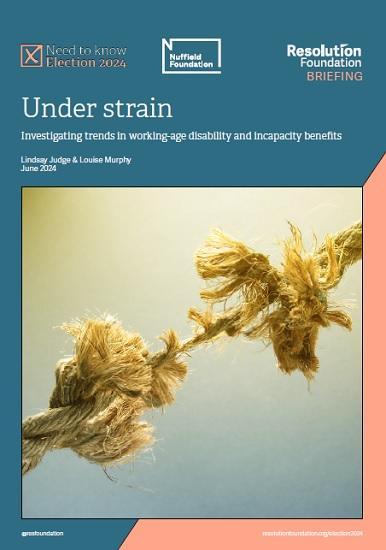Under Strain - Investigating Trends In Working-age Disability And Incapacity Benefits
22nd June 2024

The benefits bill is frequently the subject of intense political debate.
But since the pandemic, working-age health-related benefits have moved centre-stage in these discussions, as policy makers aim to understand what sits behind the historical rise in claims, and to contain future pressures too.
In this briefing note - part of our Election 2024 work but also the first from a new Resolution Foundation research programme examining how disability, ill-health and the economy intersect - we investigate trends in working-age disability and incapacity benefits, asking what really sits behind the numbers that are understandably causing concern in Britain today.
The analysis in this briefing note suggests that restricting eligibility for such benefits, without fully understanding the complex set of underlying drivers, is risky in the extreme, not least because those in receipt of such benefits are financially insecure. Instead, a serious strategy to control expenditure on working-age incapacity and disability benefits requires government to understand the complex range of drivers that determine this spend.
Key findings
In the years between 2013-14 and 2022-23 (the latest year of outturn data), real spending on working-age incapacity benefits increased by 34 per cent, and that on disability benefits rose by 89 per cent. In 2013-14, Britain spent £28 billion (in 2024-25 prices) on these two working-age benefit types; by 2022-23, that figure had increased to £43 billion.
A growing, ageing population and a rising State Pension Age have by themselves boosted the working-age disability benefits caseload by 272,000 between 2013 and 2023, one-quarter (25 per cent) of the increase over that time.
In 2012-13, 5.9 million (16 per cent) working-age adults in Great Britain reported that they had a disability (defined as having a long-standing illness, disability or impairment which causes substantial difficulty with day-to-day activities); by 2022-23, that figure had risen to 8.9 million (23 per cent).
Although awareness of health-related benefits has increased, and the stigma attached to claiming declined, there is scant evidence to suggest it is ‘easier' to be awarded disability benefits today, with award rates for new PIP claims broadly steady at around 45 per cent since 2015-16.
Changes to the benefits system over the last decade have strengthened the incentive to claim incapacity and disability benefits. In April 2010, a single person claiming unemployment benefit received £98 a week (in 2024-25 prices); by April 2024, that figure has fallen 7.6 per cent to £91, a loss especially hard-felt in the cost of living crisis.
It is critical to view incapacity and disability benefit trends in the round. Over the last 15 years, the share of GDP spent on all working-age benefits has barely changed, standing at 3.9 per cent in both the pre-recession year of 2007-08 and in 2022-23, although it is forecast to reach 4.6 per cent in 2028-29.
Read the full Resolution Foundation report HERE
Pdf 38 Pages
